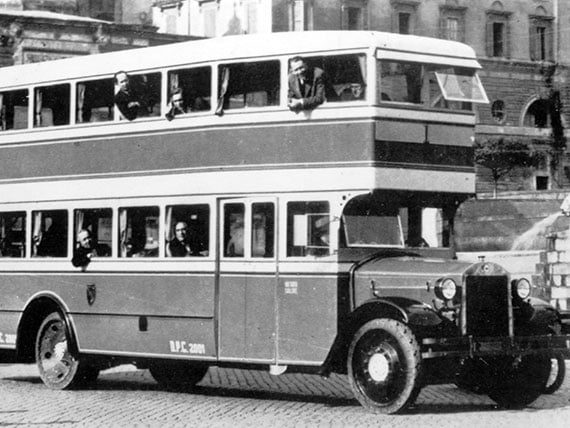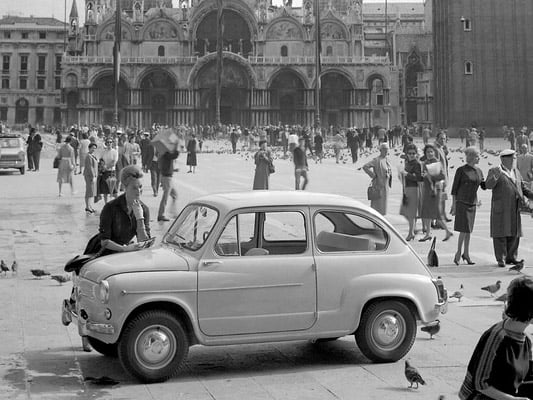
1953/55 in the very early 1950s, Ugo acquired the Renate-Veduggio-Zoccorino-Seregno public line. Thereafter he enlarged the fleet of vehicles, withdrawing 4 coaches from the Alcione bus line and related permits, and expanded his reach with the opening of another public line: the Adro-Capriolo-Monza-Desio-Seregno.
Work is always increasing and the Franciacorta-Veduggio public line (Onofri brothers) also arrives.
1956/60: While during the week the transportation of workers is thought of, for the holidays, Enrica begins to organize the first trips with lunch in a restaurant included. The places most in demand are the cities of art: Turin, Mantua, Parma and places of religious interest such as Caravaggio and Padua.
1960/62: With the closure of the Seregno-Giussano tramway line, Ugo manages to get a concession for the line connecting the two cities, which he operates with his own vehicles.
At the suggestion of his wife Enrica, Ugo grasps another great need of the time: the transportation of children and young people to schools. He opened the private line to the “De Amicis” College in Cantù and, on the strength of this experience, managed to resell the service to the municipalities of Giussano, Mariano, Cantù, Carate, Meda, Novedrate, Inverigo and Arosio.
Work is always increasing and the Franciacorta-Veduggio public line (Onofri brothers) also arrives.
1956/60: While during the week the transportation of workers is thought of, for the holidays, Enrica begins to organize the first trips with lunch in a restaurant included. The places most in demand are the cities of art: Turin, Mantua, Parma and places of religious interest such as Caravaggio and Padua.
1960/62: With the closure of the Seregno-Giussano tramway line, Ugo manages to get a concession for the line connecting the two cities, which he operates with his own vehicles.
At the suggestion of his wife Enrica, Ugo grasps another great need of the time: the transportation of children and young people to schools. He opened the private line to the “De Amicis” College in Cantù and, on the strength of this experience, managed to resell the service to the municipalities of Giussano, Mariano, Cantù, Carate, Meda, Novedrate, Inverigo and Arosio.
HISTORICAL CONTEXT AND CURIOSITY

In 1953, a factory worker's salary is 30,000 liras per month; a coffee costs 30 liras.
These are the years of the economic boom: industry registers 84 percent growth between 1953 and 1961. Also thanks to a high labor supply due to a strong flow of migration from the countryside to the cities and from the south to the north. And in this view, labor transportation is a key point.
In these years, borders begin to open with the first cooperations among EU countries: in 1957 the EEC European Economic Community and the MEC European Common Market are born, preceded in 1951 by the ECSC European Coal and Steel Community. European exports and trade increase, further boosting the economy.
On Feb. 28, 1953, biologist Francis Crick discovers the structure of DNA and announces “We have found the secret of life,” perhaps unaware of the magnitude of the discovery that would set a new course for scientific research.
On Jan. 3, 1954, Italian television was born, as RAI began broadcasting. The event is followed by 15,000 sets throughout the country, distributed among homes and bars where thousands of Italians are gathered.
On February 9, 1955, the first Italian subway was inaugurated in Rome, further evidence of people's growing mobility needs.
On March 9, 1955, the quintessential symbol of the boom years is unveiled: the Fiat 600. The hatchback that kicks off mass motorization.
In 1956 the world starts dancing to rock & roll with Elvis Presley.
On October 4, 1957, Sputnik 1, the first satellite in history is launched into space. The event decreed the unexpected overtaking of the Soviet Union over the United States in the convulsive space race, which would pit the two superpowers against each other until the late 1960s. And it is still Russian record that on April 12, 1961, sees the first man in space, Jurij Alekseevič Gagarin, who with his spacecraft manages to perform a full Earth orbit before re-entering the atmosphere
In 1958 the first credit card debuts in Italy: consumption continues to grow.
In 1960 the Alpitour all-inclusive package travel formula is born.
In 1961 the centenary of the Unification of Italy is celebrated.
These are the years of the economic boom: industry registers 84 percent growth between 1953 and 1961. Also thanks to a high labor supply due to a strong flow of migration from the countryside to the cities and from the south to the north. And in this view, labor transportation is a key point.
In these years, borders begin to open with the first cooperations among EU countries: in 1957 the EEC European Economic Community and the MEC European Common Market are born, preceded in 1951 by the ECSC European Coal and Steel Community. European exports and trade increase, further boosting the economy.
On Feb. 28, 1953, biologist Francis Crick discovers the structure of DNA and announces “We have found the secret of life,” perhaps unaware of the magnitude of the discovery that would set a new course for scientific research.
On Jan. 3, 1954, Italian television was born, as RAI began broadcasting. The event is followed by 15,000 sets throughout the country, distributed among homes and bars where thousands of Italians are gathered.
On February 9, 1955, the first Italian subway was inaugurated in Rome, further evidence of people's growing mobility needs.
On March 9, 1955, the quintessential symbol of the boom years is unveiled: the Fiat 600. The hatchback that kicks off mass motorization.
In 1956 the world starts dancing to rock & roll with Elvis Presley.
On October 4, 1957, Sputnik 1, the first satellite in history is launched into space. The event decreed the unexpected overtaking of the Soviet Union over the United States in the convulsive space race, which would pit the two superpowers against each other until the late 1960s. And it is still Russian record that on April 12, 1961, sees the first man in space, Jurij Alekseevič Gagarin, who with his spacecraft manages to perform a full Earth orbit before re-entering the atmosphere
In 1958 the first credit card debuts in Italy: consumption continues to grow.
In 1960 the Alpitour all-inclusive package travel formula is born.
In 1961 the centenary of the Unification of Italy is celebrated.

